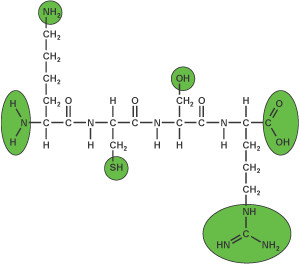Peptide modification (1)
The C-terminus, N-terminus, or intermediate position of the polypeptide can be modified. In order to be able to connect the modified groups, some standard groups on the polypeptide need to be freed, such as: n-terminal amino group, lysine amino group, cysteine mercaptan group, serine, threonine, tyrosine hydroxyl group, arginine C=N and C-terminal carboxylate group.

N-terminal acetylation/C-terminal amidation
Peptides synthesized chemically usually have a free amino group (N terminal) and a free carboxyl group (C terminal).
N-terminal acetylation and C-terminal amidation reduce the total charge of the peptide, so its total solubility may be reduced. However, the stability of peptides can also be improved as terminal acetylation and amidation produce mimics that more closely resemble natural proteins. So these modifications can improve the biological activity of peptides.
Advantages of modified peptides
1:Eliminating the terminal charge of the peptide makes it more similar to the parent protein and enhances its ability to enter the cell. If your experiment is related to intracellular, in vivo, or in vitro functional studies, we recommend N-terminal acetylation/C-terminal amidation of synthetic peptides.
2:The stability of peptide was enhanced and its resistance to protease, end-lysozyme and synthetase was improved.
3:Amidation can not only enhance the activity of polypeptide hormones, but also prolong their preservation time.:
4:The influence of N-terminal amino and C-terminal carboxyl charges on Elisa detection can be eliminated.
Available modification example
| N-terminal | C-terminal |
| {Ac},Acetylation | {NH2},Amidation |
| {For},Formylation | {CHO}, Peptide Aldehydes |
| {Fmoc},9-Fluorenylmethyloxycarbonyl | {CMK}, Chloromethylketone |
| {Suc},succinyl;{MeO-Suc} | {AMC},7-Amino-4-Methylcoumarin |
| {Myr}, Myristic acid | {OL}, Alcohol Peptide |
| {Mal}, Maleimide | {pNA},p-Nitroaniline |
| {mPEG2000}, {mPEG3000}, {mPEG5000}, Mal-PEG12 | ED,{AFC}, -OMe,-OtBu |
Copyright © 2020 Omizzur Inc | Terms & Conditions | Privacy Notice | Sitemap